Some daily events in the changing sky for November 14 – 22.
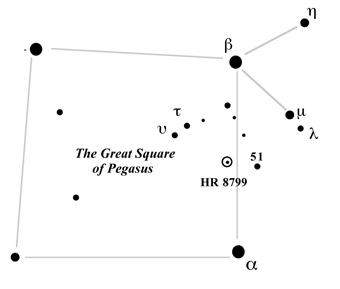
This sky map shows the location of 6th-magnitude HR 8799. The star is just barely visible to the naked eye under very dark skies. Its spectral type is A5, making it somewhat larger and hotter and 5 times as luminous as the Sun. It's located 130 light-years from Earth. By coincidence, it lies just 2½° east of 51 Pegasi, the first solar-type star discovered to have a planet.
Christian Marois
Friday, November 14
Saturday, November 15
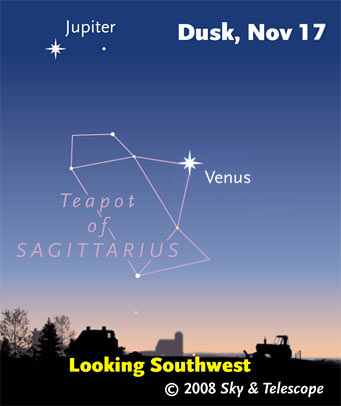
Monday evening the 17th, look for 2nd-magnitude Lambda Sagittarii, the star marking the top of the Teapot, 0.1° from Venus. Binoculars help.
S&T Illustration
Early Sunday morning, telescope users along a track from southern Ontario to the Carolinas can watch for a 9.6-magnitude star in Gemini, near the zenith, to be occulted by the faint, slow-moving asteroid Klotilde for up to 23 seconds. For charts and details see Steve Preston's asteroid occultation site.
Sunday, November 16
Monday, November 17
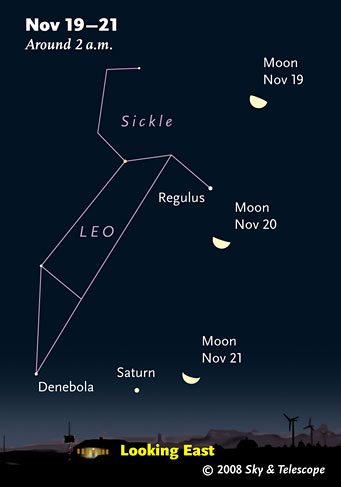
The waning Moon passes Regulus and Saturn in the feet of Leo in the early morning hours. (These scenes are drawn for the middle of North America. European observers: move each Moon symbol a quarter of the way toward the one for the previous date. For clarity, the Moon is shown three times actual size.)
Sky & Telescope diagram
Tuesday, November 18
Wednesday, November 19
Thursday, November 20
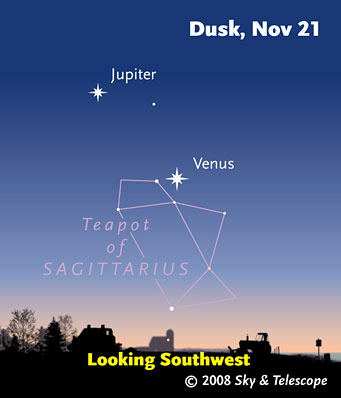
Getting closer. . . .
Sky & Telescope diagram
Friday, November 21
Saturday, November 22
Want to become a better amateur astronomer? Learn your way around the constellations. They're the key to locating everything fainter and deeper to hunt with binoculars or a telescope. For an easy-to-use constellation guide covering the whole evening sky, use the big monthly foldout map in each issue of Sky & Telescope, the essential magazine of astronomy. Or download our free Getting Started in Astronomy booklet (which only has bimonthly maps).

The Pocket Sky Atlas plots 30,796 stars to magnitude 7.6 — which may sound like a lot, but it's still less than one per square degree on the sky. Also plotted are many hundreds of good telescopic galaxies, star clusters, and nebulae.
Sky & Telescope
Once you get a telescope, to put it to good use you'll need a detailed, large-scale sky atlas (set of maps; the standards are Sky Atlas 2000.0 or the smaller Pocket Sky Atlas) and good deep-sky guidebooks (such as Sky Atlas 2000.0 Companion by Strong and Sinnott, the even more detailed Night Sky Observer's Guide by Kepple and Sanner, or the classic Burnham's Celestial Handbook). Read how to use them effectively.
Can a computerized telescope take their place? As Terence Dickinson and Alan Dyer say in their Backyard Astronomer's Guide, "A full appreciation of the universe cannot come without developing the skills to find things in the sky and understanding how the sky works. This knowledge comes only by spending time under the stars with star maps in hand and a curious mind." Without these, they wisely say, "the sky never becomes a friendly place."
More beginners' tips: "How to Start Right in Astronomy".
This Week's Planet Roundup
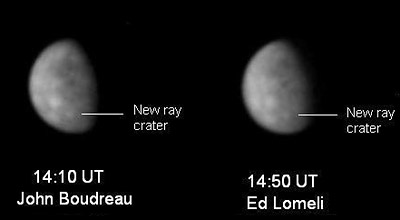
Two planetary imagers a continent apart took these extraordinary infrared views of Mercury's surface markings within 40 minutes of each other on October 27th (through broad daylight). Many of the subtle features are the same in both views — proving that they are real markings on the planet, rather than processing-exaggerated noise or flaws. The small white spot labeled "New ray crater" lies in an area not imaged by the Messenger spacecraft. Click image for more information.
John Boudreau / Ed Lomeli / Frank Mellilo
Mercury is hidden in the glare of the Sun.
Venus and Jupiter (magnitudes –4.1 and –2.1, respectively) shine brightly in evening twilight. They're in the southwest, with brighter Venus to Jupiter's lower right. Watch them close in on each other for the rest of November, by 1° per day. They're 16° apart on November 14th and only 8° apart on the 22nd. These two brightest planets are heading toward a spectacular conjunction, 2° apart, on November 30th and December 1st — when the crescent Moon will join in!
In a telescope Venus is still small (15 arcseconds wide) and gibbous (73% illuminated). Jupiter is 35″ wide but has a much lower surface brightness, being seven times farther from the Sun.
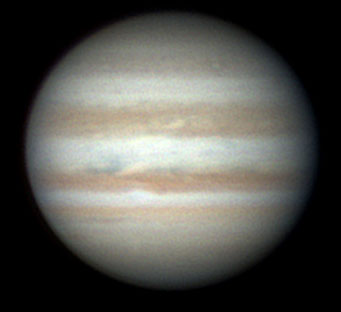
As it moves farther westward in the evening sky, Jupiter has gotten small (35 arcseconds wide this week) and low, so don't be disappointed if your scope shows very little on it. Even world-class planetary imager Christopher Go recorded only this rather fuzzy view on November 16th (at 9:43 UT).
South is up, to match the view in many telescopes. Note the white outbreak in the South Equatorial Belt near the central meridian. The CM II longitude was 277°.
Mars is hidden in the glare of the Sun.
Saturn (magnitude +1.1, in the hind feet of Leo) rises around 1 or 2 a.m. standard time and shines high in the southeast by early dawn. Don't confuse it with Regulus 20° (two fist-widths at arm's length) to its upper right.
A telescope will show that Saturn's rings have turned nearly edge on; they're currently tilted 2° to our line of sight and closing. They'll reach a minimum of 0.8° at the end of the year, then start opening again before finally closing to edge-on next September.
Uranus and Neptune (magnitudes 5.8 and 7.9, respectively, in Aquarius and Capricornus) are in the south during early evening. Use our article and finder charts or the chart in the September Sky & Telescope, page 63.
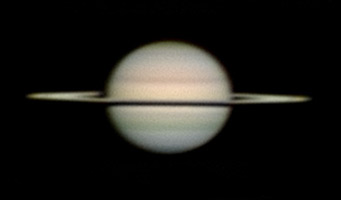
Saturn's rings were tipped only 2° to our line of sight on November 1, 2008, when Tomio Akutsu of Cebu, Philippines, took this image. Note the very prominent black shadow of the rings on the globe. South is up.
Tomio Akutsu
Pluto is lost in the sunset.
All descriptions that relate to your horizon or zenith — including the words up, down, right, and left — are written for the world's mid-northern latitudes. Descriptions that also depend on longitude (mainly Moon positions) are for North America. Eastern Standard Time (EST) equals Universal Time (known as UT, UTC, or GMT) minus 5 hours.
To be sure to get the current Sky at a Glance, bookmark this URL:
http://SkyandTelescope.com/observing/ataglance?1=1
If pictures fail to load, refresh the page. If they still fail to load, change the 1 at the end of this URL to any other character and try again.
 0
0
Comments
You must be logged in to post a comment.